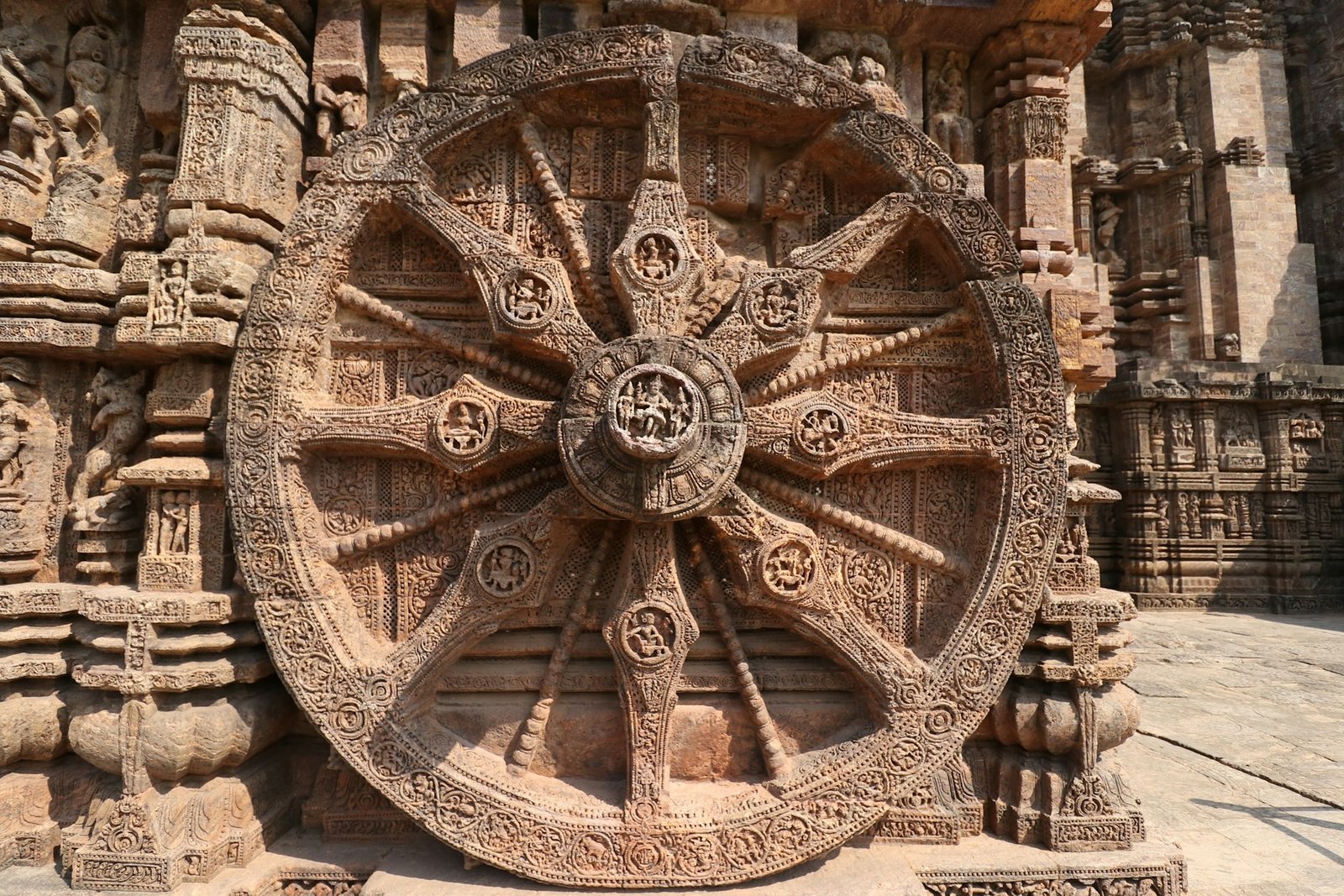Outstanding Universal Value of Sun Temple Konarak
The Sun Temple Konarak, located on the shores of the Bay of Bengal, is one of India’s most iconic cultural and architectural treasures. Constructed in the 13th century by King Narasimha Deva I of the Eastern Ganga dynasty, the temple was envisioned as the celestial chariot of Surya, the Sun God. Its 24 intricately carved wheels, each over three meters in diameter, represent the cycle of time and the months of the year, while seven majestic horses symbolize the seven days of the week. Together, they create the impression of divine movement across the heavens.
Recognized as a UNESCO World Heritage Site, the temple embodies both the religious devotion of its age and the extraordinary skill of its artisans. It stands as a masterpiece of Kalingan architecture, blending spiritual symbolism, monumental scale, and intricate detailing, making it one of the greatest temple complexes in India.
Architectural Grandeur of the Sun Temple Konarak
The Sun Temple is often described as a poetic creation in stone. The entire complex was designed as Surya’s chariot, capturing the essence of celestial motion and divine power. The temple originally featured a towering vimana (sanctuary), which soared nearly 70 meters high but collapsed in the 19th century. Despite this loss, the remaining structures—such as the jagamohana (audience hall) and natmandir (dance hall)—still radiate magnificence.
The walls and plinth of the temple are richly decorated with intricate carvings. These include depictions of lions overpowering elephants, symbolizing strength, as well as scenes of daily life such as dancers, musicians, warriors, and lovers. Erotic sculptures, similar in theme to those found in Khajuraho, illustrate the tantric traditions of the period and highlight the integration of spirituality with the cycle of human life.
The alignment of the temple is also significant. Facing east, it was designed so that the first rays of the rising sun illuminated the image of Surya in the sanctum, symbolizing the eternal relationship between cosmic energy and earthly worship.
Legends and Historical Impressions
Like many Indian temples, Konarak is not just an architectural wonder but also a repository of fascinating legends. One of the most enduring stories is about its chief architect, Bisu Moharana, who left his family behind to devote himself to the temple’s construction. His son, Dharmapada, grew up during the years of construction and later joined the workforce. According to folklore, Dharmapada solved a critical architectural challenge that even his father had been unable to complete. However, fearing that his solution would be seen as a flaw or spark controversy, he sacrificed himself by leaping from the temple to protect the dignity of his father and fellow artisans.
Another widely shared tale recounts that it took 1,200 artisans 12 years to build the temple. This legend reinforces the temple’s reputation as not only an architectural achievement but also a monument to devotion, sacrifice, and perseverance.
Symbolism and Cultural Significance
The Sun Temple Konarak is far more than a physical structure—it is a symbolic embodiment of time, creation, and divinity. The 24 wheels represent the hours of the day and the months of the year, while the spokes of each wheel serve as sundials, capable of telling time with surprising accuracy. The horses signify the passage of days, propelling the chariot of the Sun God across the sky.
Through its sculptures and iconography, the temple conveys messages about spirituality, morality, and the interconnectedness of life. Scenes of festivals, royal processions, agricultural practices, and martial displays give insight into the socio-political world of 13th-century Odisha. The erotic carvings are believed to represent fertility, cosmic energy, and the balance between physical and spiritual existence.
Integrity and Conservation
Over centuries, the Sun Temple has faced challenges from natural disasters, saline winds from the Bay of Bengal, and structural collapse. The vimana no longer stands, but the jagamohana, natmandir, and the intricately carved wheels remain preserved. Conservation efforts by the Archaeological Survey of India (ASI) have been crucial in maintaining the monument.
Modern challenges include urbanization, environmental degradation, and increased tourism pressure. Yet, the temple continues to inspire awe and remains a living cultural landmark, celebrated during festivals like Chandrabhaga Mela, when thousands gather to honor Surya with prayers, music, and dance.
Visiting the Sun Temple Konarak
- Location: Konarak, Odisha, India (65 km from Bhubaneswar, 35 km from Puri)
- Opening Hours: Daily, sunrise to sunset
- Entry Fee: Nominal charges apply for Indian and foreign visitors (per ASI guidelines)
- Best Time to Visit: October to March, when the weather is pleasant and coincides with the Konark Dance Festival, showcasing classical Indian dance in the backdrop of the temple.
Nearby attractions include the sacred Jagannath Temple in Puri, the serene beaches of Chandrabhaga, and the ancient temples of Bhubaneswar, creating a cultural circuit rich in heritage and spirituality.
Conclusion
The Sun Temple Konarak is not just an archaeological wonder but a profound symbol of India’s cultural and spiritual heritage. From its conception as Surya’s cosmic chariot to its intricate carvings that narrate life in 13th-century Odisha, the temple represents the pinnacle of Kalingan architecture and artistic creativity. Despite the ravages of time, it continues to embody the devotion, genius, and vision of its creators.
A visit to Odisha is incomplete without witnessing the magnificence of this UNESCO World Heritage monument. Whether you come for its history, architecture, or spiritual significance, the Sun Temple Konarak leaves every visitor inspired by its grandeur and timeless legacy.


0 Comment